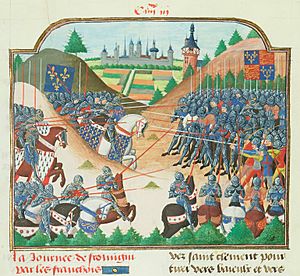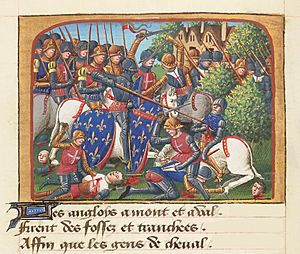Battle of Formigny facts for kids
Quick facts for kids Battle of Formigny |
|||||||
|---|---|---|---|---|---|---|---|
| Part of the Hundred Years' War | |||||||
 Illumination adorning La Cronicque du temps de Tres Chrestien Roy Charles, septisme de ce nom, roy de France by Jean Chartier, c. 1470–1479 |
|||||||
|
|||||||
| Belligerents | |||||||
| Commanders and leaders | |||||||
| Strength | |||||||
| c. 4,200 | c. 4,000 to 4,300 | ||||||
| Casualties and losses | |||||||
| 500 to 1,000 killed or wounded | Vast majority killed or captured | ||||||
The Battle of Formigny, fought on 15 April 1450, was a major battle of the Hundred Years' War between England and France. A decisive French victory that destroyed the last significant English field army in Normandy, it paved the way for the capture of their remaining strongholds.
Although its impact on the result is debatable, Formigny is thought to be the first major engagement where artillery was present on the battlefield, having been previously confined to siege warfare.
Contents
Background
Directed by Charles VII, the French used the time afforded them by the 1444 Treaty of Tours to reorganize and reinvigorate their armies. Lacking clear leadership, the English in contrast were scattered and dangerously weak. This meant the French were in a much stronger position when they broke the truce in June 1449. By August, they had taken Pont-Audemer, Pont-L'Evêque and Lisieux, and by October had occupied much of Normandy. Cutting north and east, the Bureau brothers captured Rouen in October, Harfleur in December, then Honfleur and Fresnoy in January 1450, before investing Caen.
During the winter of 1449, the English assembled an expeditionary force in Portsmouth to relieve Caen. It was led by Sir Thomas Kyriell, a relatively unknown commander who would be comprehensively out manoeuvred by his French opponents. Lack of money and supplies hampered recruiting and lowered morale; in January 1450 the troops lynched an official sent to negotiate with them over pay.
On 15 March 1450, Kyriell and some 2,500 men landed in Cherbourg, where they were reinforced by another 1,800 collected by Edmund Beaufort, 2nd Duke of Somerset, English commander in Normandy. He did so by taking them from English garrisons in Bayeux, Caen, and Vire, under Sir Matthew Gough, Sir Robert Vere and Sir Henry Norbury respectively.
Battle
Rather than immediately relieving Caen as originally planned, Kyriell attacked Valognes, whose possession allowed the French to isolate Cherbourg from the rest of the Cotentin peninsula. It fell on 27 March after a short siege, and Kyriell continued onto French-held Carentan, which he reached on 12 April. Despite a number of small skirmishes, Clermont, the local French commander, refused to give battle, so Kyriell instead marched for Bayeux. He stopped near Formigny on 14 April, closely followed by 3,000 men from Carentan under Clermont. On the same day, the Constable of France, Arthur de Richemont, arrived in Saint-Lô with a Breton force of 2,000, split between 1,200 cavalry and 800 infantry. Having made contact, Clermont urged him to move on Formigny as soon as possible.
On 15 April, the English sighted Clermont, and the armies took up positions facing each other on the Carentan-Bayeux road, near a small tributary of the Aure. Now totalling somewhat less than 4,000 men, of whom 2,900 were archers, the English assembled in two main "battles" across the road to Carentan, with their backs to the stream. Although they did not have time to construct the usual defence works of sharpened stakes, Kyriell was confident since he outnumbered Clermont, and was unaware of Richemont's proximity.
Pausing to assess the situation, in the early afternoon Clermont ordered his dismounted men at arms to attack the English position. These assaults were repulsed, as were two French cavalry probes of their flanks. He then instructed his two culverins to open fire; since the guns were out of effective bowshot range, the English archers were unable to respond, and left their positions in an attempt to capture them. It was now around 7:00 pm; having left his infantry behind, at this point, Richemont and his 1,200 cavalry arrived from the south, crossing the Aure and threatening the English flank. Encouraged by the presence of the king's most influential advisor, Pierre de Brézé, Clermont's forces stood their ground.
With many of his men busy dragging the captured guns back to their lines, Kyriell shifted forces to the left to face the new threat, while Clermont responded by renewing his attack. The English were caught in the open by the Breton cavalry, then enveloped by French troops under Clermont and Brézé. Attacked from both sides, they were split into small groups and suffered heavy casualties. The vast majority were either killed or captured, including Kyriell, although Sir Matthew Gough and a small party escaped to Bayeux.
Contemporary chronicles suggest that despite protestations, after the battle French infantrymen massacred about 500 captured English archers. Their corpses were later buried in a nearby field, later dubbed "The English Tomb"..
Aftermath
Kyriell's army had effectively ceased to exist, with the vast majority either killed or taken prisoner. Contemporary French records claim 3,744 bodies were buried, although this seems to have included casualties from both sides. The same sources suggest another 1,200 to 1,400 were taken prisoner, while other historians suggest 2,500 killed and 900 captured. Estimates of French and Breton losses vary from "less than a thousand", to "about 500", or "a handful". As other significant English forces in Normandy had been eliminated before the battle, the whole region quickly fell to the victorious French. Caen was captured on 12 June, and Cherbourg, the last English-held fortress in Normandy, fell on 12 August.
Prior to 1450, artillery had previously been confined to siege warfare, and Formigny is arguably the first battle in which cannon played a role on the battlefield. Unlike the better known Battle of Castillon, their impact is difficult to judge, since contemporary accounts are unclear. Arguably the arrival of the Breton cavalry on the English flank was the decisive factor, since it forced them to leave their prepared defensive position, although the French guns also played a role in making that happen.
Most significantly, the noise of their firing alerted Richemont to the fact that a battle was taking place and its rough location, so causing his appearance on the field. It was fortunate for Clermont this was so; one of his captains wrote shortly afterwards that if Richemont had not arrived when he did, Clermont's army would have suffered "irreparable damage" due to the English numerical superiority.
Images for kids
-
Bataille de Formigny, 18 avril 1450, oil on canvas by Prosper Lafaye, 1837, Palace of Versailles
Sources







